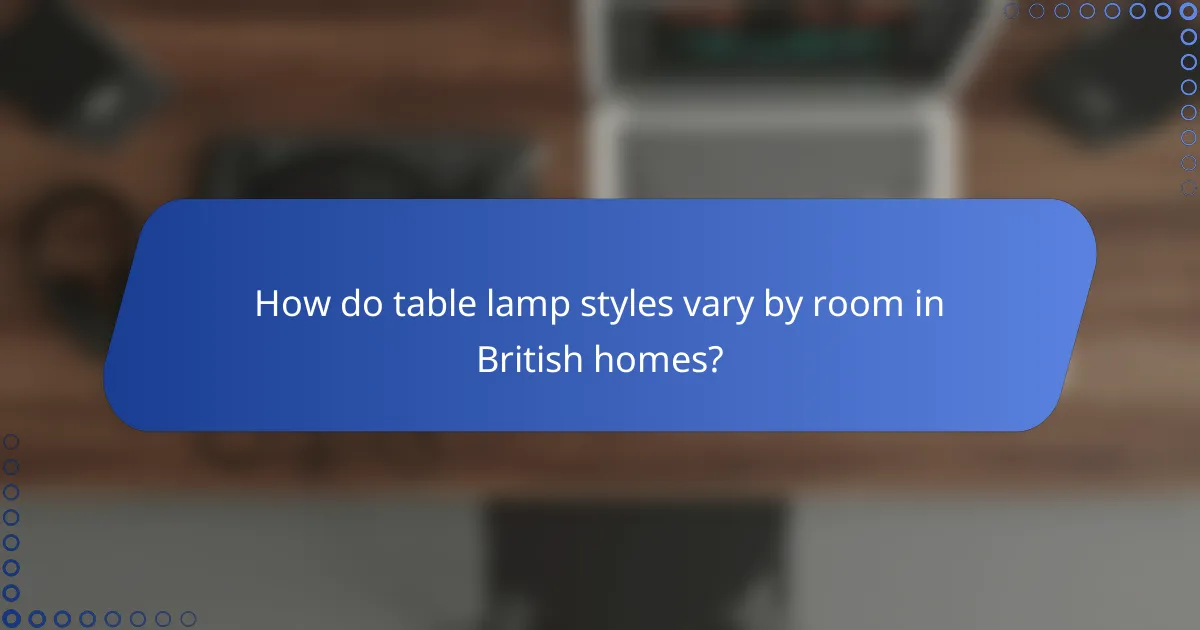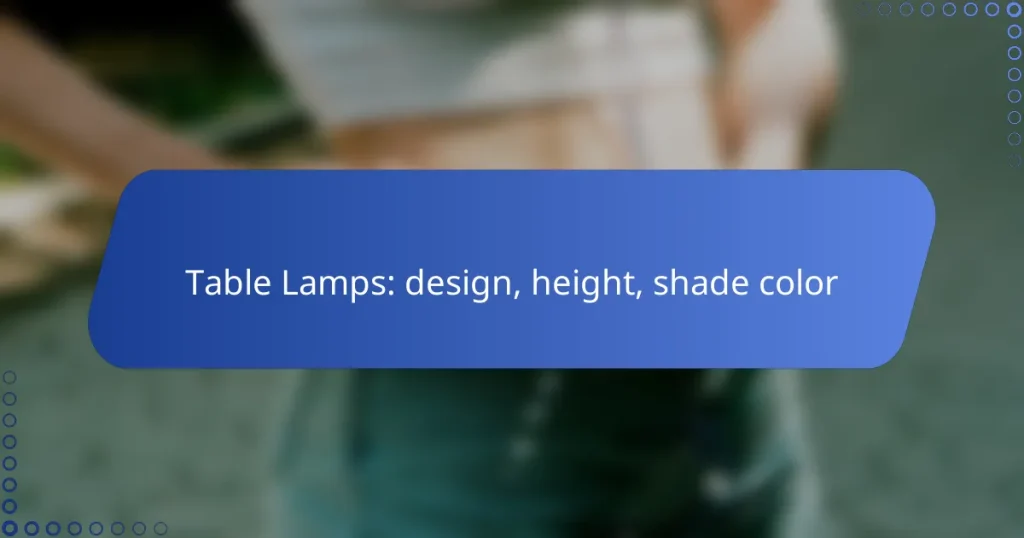Table lamps are essential elements in modern home design, combining functionality with aesthetic appeal. With a variety of styles such as contemporary, industrial, and mid-century modern, they can enhance any living space. Selecting the right height is crucial for both usability and visual harmony, while the choice of shade color can influence the overall mood of the room, offering versatility or bold statements.

What are the best table lamp designs for modern homes?
The best table lamp designs for modern homes typically emphasize functionality, aesthetics, and versatility. Popular styles include contemporary minimalist, industrial, mid-century modern, Scandinavian-inspired, and art deco, each offering unique characteristics that can enhance your living space.
Contemporary minimalist designs
Contemporary minimalist table lamps focus on simplicity and clean lines, often featuring neutral colors and geometric shapes. These designs prioritize functionality without unnecessary embellishments, making them ideal for modern interiors.
When selecting a minimalist lamp, consider options with adjustable brightness or integrated USB ports for added convenience. Look for materials like metal or glass that complement a sleek aesthetic.
Industrial style table lamps
Industrial style table lamps draw inspiration from factories and warehouses, showcasing raw materials like exposed metal and Edison bulbs. This rugged aesthetic often includes elements like pipes or concrete bases, making them a striking addition to any room.
To incorporate industrial lamps into your home, pair them with vintage or rustic decor for a cohesive look. They work well in both living rooms and home offices, providing a bold statement while remaining functional.
Mid-century modern options
Mid-century modern table lamps are characterized by their organic shapes, bold colors, and innovative materials. This design style often features wooden bases and fabric shades, creating a warm and inviting atmosphere.
When choosing a mid-century lamp, look for iconic designs that reflect the era’s aesthetic, such as tripod bases or asymmetrical shapes. These lamps can serve as focal points in a room, blending seamlessly with retro or contemporary furnishings.
Scandinavian-inspired lamps
Scandinavian-inspired table lamps emphasize simplicity, functionality, and natural materials. Often featuring light woods and soft color palettes, these designs create a cozy and inviting ambiance.
To enhance a Scandinavian look, choose lamps with soft, diffused lighting and minimalistic forms. They are perfect for creating a serene atmosphere in living rooms or bedrooms, complementing the overall Scandinavian design ethos.
Art deco table lamps
Art deco table lamps are known for their luxurious materials, geometric patterns, and bold colors. This style often incorporates glass, chrome, and intricate detailing, making them statement pieces in any modern home.
When selecting an art deco lamp, consider its placement as a centerpiece on a side table or console. These lamps can add a touch of glamour and sophistication to your decor, especially when paired with complementary art deco furnishings.

How to choose the right height for a table lamp?
Choosing the right height for a table lamp is essential for both functionality and aesthetics. The ideal lamp height should complement the surrounding furniture and provide adequate light for its intended use.
Standard height recommendations
Standard table lamp heights typically range from 24 to 32 inches when measured from the base to the top of the shade. For general use, a lamp should be positioned so that the bottom of the shade is at eye level when seated, usually around 30 inches for a standard sofa or chair.
For task lighting, such as reading, a slightly taller lamp may be beneficial, while decorative lamps can vary more widely in height. Always consider the scale of the table and surrounding decor when selecting a lamp.
Adjustable height options
Adjustable height lamps offer flexibility, allowing you to customize the height based on your needs. These lamps often feature mechanisms such as telescoping poles or adjustable arms, making them ideal for multi-functional spaces.
When choosing an adjustable lamp, ensure that the mechanism is sturdy and easy to operate. This feature is particularly useful in homes where lighting needs may change frequently, such as between reading and ambient lighting.
Considerations for bedside table lamps
For bedside table lamps, height is crucial for comfort and accessibility. A common recommendation is to have the lamp height between 24 to 28 inches, ensuring that the light source is easily reachable while lying in bed.
Additionally, consider the height of the mattress and the bedside table. The lamp should provide adequate illumination without being too tall to obstruct your view or too short to be ineffective. A good rule of thumb is for the bottom of the shade to be about 15 inches above the mattress level.

What shade colors work best for table lamps?
When selecting shade colors for table lamps, consider the room’s overall design and the mood you want to create. Neutral shades provide versatility, while bold colors can serve as striking focal points.
Neutral shade colors
Neutral shade colors, such as white, beige, and gray, are ideal for creating a calm and cohesive atmosphere. They blend seamlessly with various decor styles and allow other elements in the room to stand out.
These shades are particularly effective in spaces where you want to maintain a light and airy feel, such as living rooms or bedrooms. They can also enhance the brightness of the room by reflecting light effectively.
Bold and vibrant shade options
Bold and vibrant shade options, like deep red, royal blue, or bright yellow, can add personality and energy to a space. These colors often serve as statement pieces, drawing attention and creating visual interest.
When using bold shades, consider the surrounding decor to ensure harmony. Pairing a vibrant lamp with more subdued furnishings can create a balanced look, while clustering multiple bold colors can energize a room.
Translucent vs. opaque shades
Translucent shades allow light to diffuse softly, creating a warm ambiance, while opaque shades provide focused illumination. The choice between them depends on the intended use of the lamp and the desired lighting effect.
Translucent shades are great for general lighting and can soften harsh light, making them suitable for bedrooms or cozy reading nooks. In contrast, opaque shades are better for task lighting, such as in home offices or kitchens, where direct light is needed.

What are the key features to consider when buying a table lamp?
When buying a table lamp, consider factors such as light bulb compatibility, switch type preferences, and material durability. These features impact functionality, ease of use, and the lamp’s longevity in your space.
Light bulb compatibility
Light bulb compatibility is crucial as it determines the type of bulbs you can use with your lamp. Most table lamps support standard incandescent, LED, or CFL bulbs, but checking the socket type and wattage limit is essential for safety and performance.
For example, a lamp designed for a maximum of 60 watts should not be paired with a bulb exceeding this limit. Additionally, consider the color temperature of the bulbs; warmer tones (around 2700K) create a cozy atmosphere, while cooler tones (above 4000K) are better for task lighting.
Switch type preferences
The switch type on a table lamp affects convenience and usability. Common options include rotary switches, push-button switches, and touch-sensitive controls. Each type offers different user experiences; for instance, touch-sensitive lamps are often easier to operate when your hands are full.
When choosing a switch, think about your lifestyle. If you frequently adjust the lamp’s brightness, look for models with dimmer switches. Also, consider the placement of the switch for easy access, especially if the lamp is positioned on a high shelf or behind furniture.
Material durability
Material durability influences the lamp’s lifespan and aesthetic appeal. Common materials include metal, glass, and plastic, each offering distinct advantages. Metal lamps tend to be sturdier and more resistant to wear, while glass lamps can provide a more elegant look but may be more fragile.
When selecting a lamp, consider your environment. If you have pets or children, a durable material like metal or a sturdy plastic may be preferable. Additionally, check for finishes that resist scratches and tarnishing to maintain the lamp’s appearance over time.

How do table lamp styles vary by room in British homes?
Table lamp styles in British homes differ significantly by room, reflecting both functionality and aesthetic preferences. Each space has unique lighting needs, which influence the choice of design, height, and shade color.
Living room table lamp styles
In the living room, table lamps often serve as both functional lighting and decorative accents. Popular styles include contemporary designs with sleek lines, traditional lamps with ornate bases, and industrial models featuring metal finishes.
Height is a key consideration, with lamps typically ranging from 50 to 70 cm to provide adequate illumination without obstructing sightlines. Shade colors vary widely, but neutral tones like white or beige are commonly chosen to complement various decor themes.
Bedroom lamp preferences
Bedroom lamps prioritize soft, ambient lighting to create a relaxing atmosphere. Common styles include bedside lamps with fabric shades and minimalist designs that blend seamlessly with bedroom furniture.
Height preferences for bedroom lamps usually fall between 40 to 60 cm, allowing for easy reach from the bed. Shades in calming colors such as soft pastels or muted tones are favored to enhance the tranquil environment.
Office desk lamp choices
In home offices, table lamps focus on providing bright, focused light for work tasks. Adjustable designs are popular, allowing users to direct light where needed, while modern styles often feature energy-efficient LED bulbs.
Desk lamps typically range from 30 to 50 cm in height, ensuring they fit comfortably on desks without taking up excessive space. Shade colors are often practical, with white or light grey shades preferred for their ability to diffuse light effectively and reduce glare.

What are the top brands for table lamps in the UK?
In the UK, some of the leading brands for table lamps include Anglepoise, John Lewis, and Habitat. These brands are known for their quality, design variety, and innovative features, catering to different styles and budgets.
Design
When selecting a table lamp, design is crucial as it influences the overall aesthetic of a room. Popular styles include modern, industrial, vintage, and minimalist, each offering unique characteristics. Consider how the lamp’s design complements your existing decor and whether it serves as a statement piece or a subtle addition.
Materials also play a significant role in design. Common options include metal, glass, ceramic, and wood. Each material brings a different texture and feel, so choose one that aligns with your style preferences and the atmosphere you want to create.
Height
The height of a table lamp affects its functionality and visual impact. Standard table lamps typically range from about 14 to 30 inches tall. A lamp should be positioned so that the bottom of the shade is at eye level when seated, ensuring optimal light distribution.
For side tables or desks, consider the height of the furniture. A lamp that is too tall may overwhelm the space, while one that is too short may not provide adequate lighting. A good rule of thumb is to select a lamp that is roughly one-third the height of the table it will sit on.
Shade Color
Shade color significantly influences the quality of light emitted by the lamp. Lighter shades, such as white or cream, tend to diffuse light more effectively, creating a bright and airy atmosphere. Darker shades can produce a more intimate and cozy feel but may limit light output.
When choosing a shade color, consider the room’s color palette and the mood you want to establish. Neutral shades offer versatility, while bold colors can serve as focal points. Additionally, the material of the shade can affect light diffusion, so explore options like fabric, glass, or paper for different effects.


